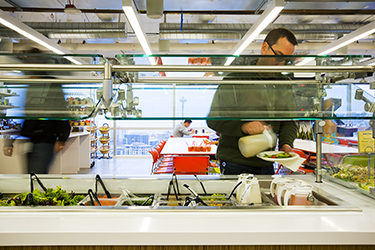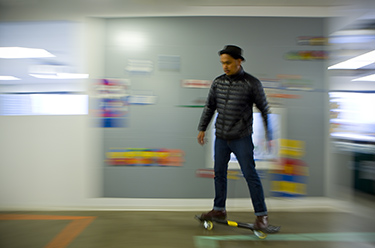|
Subscribe / Renew |
|
|
Contact Us |
|
| ► Subscribe to our Free Weekly Newsletter | |
| home | Welcome, sign in or click here to subscribe. | login |
Architecture & Engineering
| |
 |
October 31, 2013
Tech influence ripples across the design world
Gensler

Covarrubias
|
The technology sector is a constantly evolving and rapidly growing industry. As a result, employment practices in the tech industry — especially in gaming, social networking and Internet services — are beginning to influence other sectors of the economy and our culture.
The tech sector represents a highly diverse set of companies that cover a wide variety of businesses. They range from start-ups to mature companies, both large and small. Despite these variations, there are a few discernible, common trends among them.
We recently conducted our 2013 U.S. Workplace Survey, which represents responses from more than 2,000 knowledge workers. The research compares today’s workplace to that of 2008.
The survey’s findings reveal that doing business in the tech sector is quite a different animal. For example, 41 percent of tech employees report the ability to choose when and where to work, which exceeds the 32 percent average of all other industries. Another finding is that 31 percent of employees at tech companies work in top-performing work environments compared to 24 percent of all other industries.
In the highly competitive technology industry, the workplace has become an imperative tool to attract top talent and support the pursuit of innovation.
Because of the growing influence of the tech industry, these trends are rippling out into the larger economy.
So how do you design spaces within the larger work/live/learn/play environment that capture these trends? We start by recognizing the common threads.
I want choices
In the race to attract and retain top talent, enhanced amenities are becoming a big differentiator between employers. Companies will go to great lengths to keep their talent happy and provide everything they need during long work hours.
The range of amenities includes kitchens with an on-site chef and complimentary food available around the clock, fitness and yoga classes, free dry cleaning, and access to bicycles and community gardens. The list goes on and continues to grow.
As a result of the many workplace options, tech workers begin to look to the urban environment to provide the wide variety of choices they see in their workplace.
I want to be connected
This growing demographic is all about connections. Advances in technology have brought about the ability to merge the virtual, social and physical worlds.
In the same way social media connects people in a virtual world, this expectation of constant connection is also placed on the physical environment. Tech engineers expect a seamless connection wherever they are, whether in a restaurant, airport or building lobby. The places they hang out in need to provide a platform to connect to the community, yet save themselves the choice to “be together alone” (back to the first point).
I want to customize
Tech engineers are creative by nature. They are self-motivated individuals who learn through experimentation rather than through traditional means.
The virtual environment is their playground, and in like manner, they often see the physical environment as an outlet for experimentation. To this end, space becomes a canvas of self-expression and they take every opportunity to leave their personal imprint behind. They thrive on physical environments that allow some level of customization by means of elements that can move, be transformed, or allow self expression.
The idea of customization can easily be translated to other areas, whether it is where they live, learn or play.
I care for my community
Tech individuals are, for the most part, a younger generation that was raised with social environmental awareness as a core value. They don’t necessarily ascribe themselves to labels, but do value meaningful actions that reflect wellbeing and give back to the communities they live in.
Many of the companies in which these individuals work seek to support a sustainable work/life balance by promoting health and building culture within the organization. Both wellness and community are therefore at the core for these individuals and they will continue to gravitate towards neighborhoods and cities that encourage these values.
Challenging old paradigms
The technology industry is the driving force of today’s economy. It is breeding a new type of individual that is challenging old paradigms. With its proven success, it is beginning to cause other sectors of the economy, society and culture to come forth with a new approach — from planning cities to neighborhoods, parks, airports, schools, museums and buildings.
These institutions will need to break loose of their traditional and structured ways, offer a wide array of lifestyle choices that resonate with this new generation and become true experience platforms that allow multi-level connections and create communities that align with true wellbeing principles.
For example, envision airports of the future being urban centers with city amenities, parks that become active and holistic restorative environments and schools being interactive learning labs. But above all, designers need to make the employee, citizen, neighbor, traveler and shopper feel in total control over their experience in the physical environment.
Susana Covarrubias, IIDA, LEED AP, is a design director in Gensler’s Seattle office. She brings expertise in both interior design and architecture, including strategic planning.
Other Stories:
- ‘Standard of care’ is all about reasonable expectations
- A&E 2013 Surveys: BergerABAM
- A&E 2013 Surveys: Runberg Architecture Group
- A&E 2013 Surveys: PAE Consulting Engineers
- A&E 2013 Surveys: Freiheit & Ho Architects
- A&E 2013 Surveys: Fossatti Pawlak Structural Engineers
- A&E 2013 Surveys: Hewitt
- A&E 2013 Surveys: GGLO
- Architecture: It’s not science, it’s art
- Designing a waterfront entrance for Pike Place Market
- Now hear this: ADA updates listening device rules
- Can’t find a lender? Try crowdfunding
- A&E 2013 Surveys: Weber Thompson




